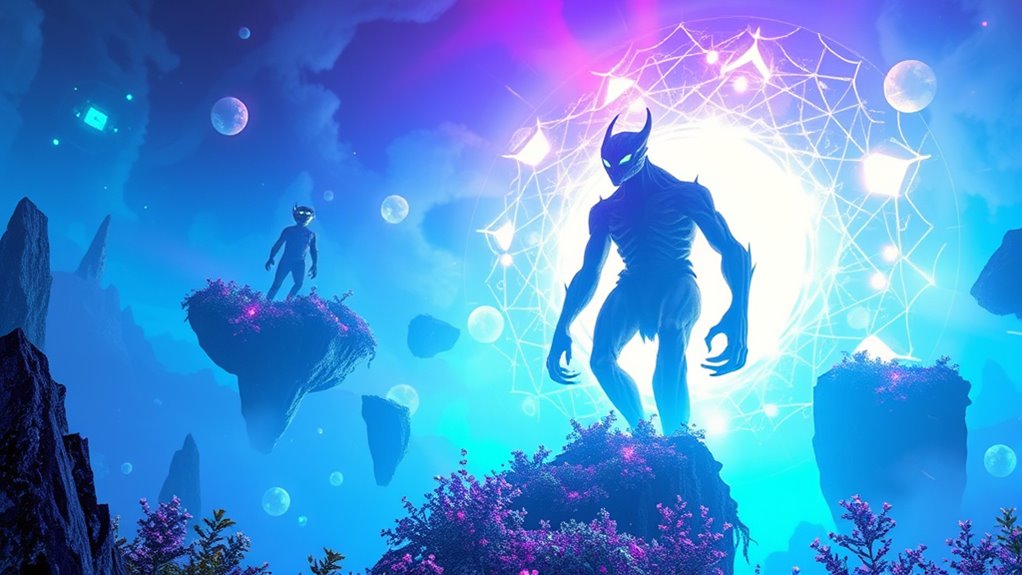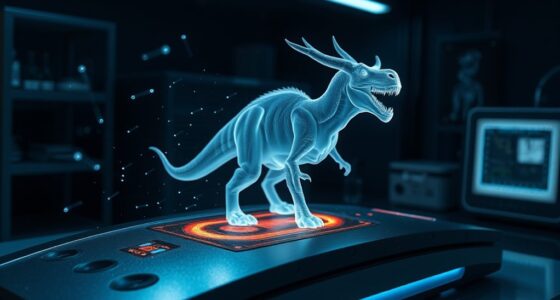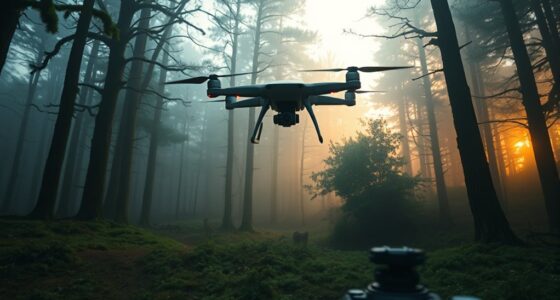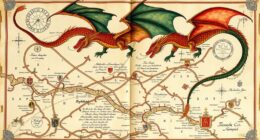In the monster metaverse, VR can help you archive cryptid encounters through immersive digital environments that recreate sightings and habitats. Advanced rendering and sensory techniques make virtual creatures feel real, allowing you to explore and document mythical animals naturally. Communities can share stories, participate in investigations, and preserve endangered folklore digitally. As technology evolves, these virtual archives will grow more detailed and interactive, offering you a deeper understanding of cryptids and their cultural ties. Keep exploring to uncover how this future unfolds.
Key Takeaways
- VR enables immersive, interactive archives of cryptid sightings, preserving detailed experiences and environmental contexts for future research.
- Digital simulations and virtual habitats facilitate pattern analysis and habitat mapping of cryptid encounters globally.
- Sensory immersion techniques, including haptic feedback and environmental cues, enhance the realism of recorded encounters.
- Virtual platforms support community-driven investigations, live events, and storytelling, fostering collective engagement and preservation.
- VR helps safeguard intangible cultural heritage by digitally reconstructing legends, rituals, and local folklore associated with cryptids.
The Evolution of Cryptid Documentation
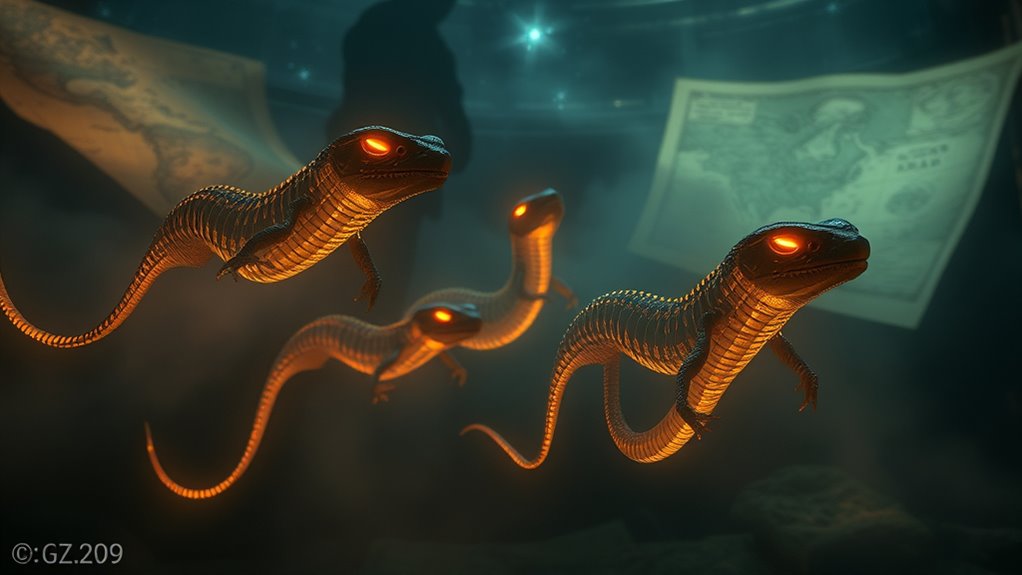
The way we document cryptids has transformed dramatically over time, moving from folklore and anecdotal reports to systematic scientific investigations. Early on, folklore analysis played a key role, as stories and legends shaped perceptions of these creatures. As interest grew, researchers began applying cryptid taxonomy to categorize and evaluate sightings more objectively. This shift allowed us to move beyond myths, analyzing evidence with scientific rigor, such as footprint casts or photographs. Today, digital tools and databases help organize reports and facilitate cross-referencing, making it easier to identify patterns or debunk false claims. This evolution reflects a broader effort to understand cryptids not just as legends but as phenomena worthy of scientific inquiry, paving the way for more credible and structured research.
Immersive Encounters: Bringing Mythical Creatures to Life
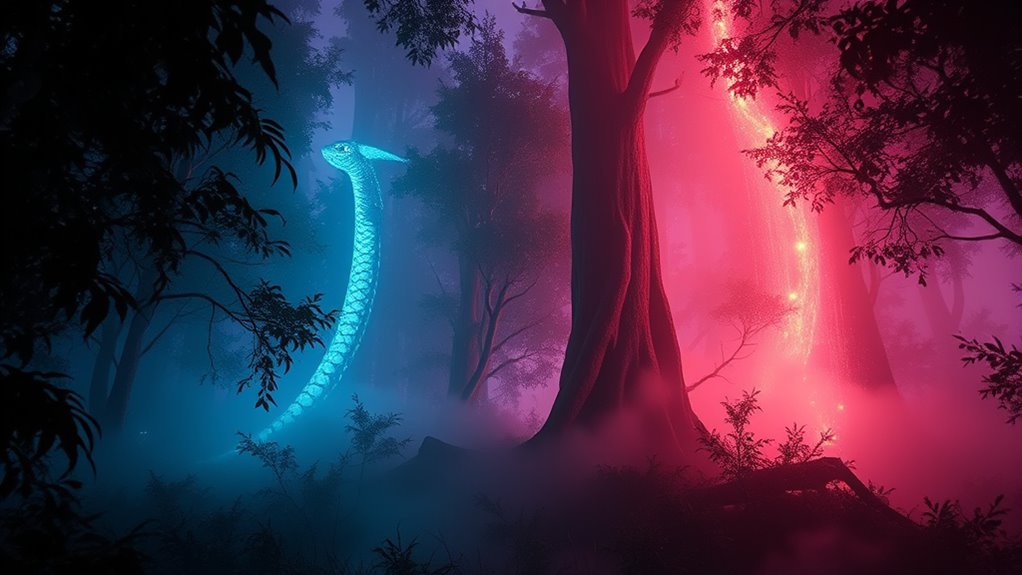
You can experience mythical creatures as if they’re truly alive through increasingly realistic virtual representations. Sensory immersion techniques, like haptic feedback and spatial audio, heighten the sense of presence. Interactive encounters let you engage directly with these beings, making the myth feel astonishingly real.
Virtual Creature Realism
Harnessing advanced rendering technologies, developers craft virtual creatures that respond convincingly to their environment, making mythical beings feel astonishingly real. They utilize creature behavior modeling to ensure these entities act naturally, reacting dynamically to your movements and surroundings. Bioluminescent displays add an extra layer of realism; glowing patterns on scales or fur illuminate their presence, especially in dark virtual settings. These visual cues mimic natural animal signals, enhancing immersion and believability. Developers constantly refine animations and physics to ensure creatures exhibit lifelike movements, from graceful sways to sudden reactions. This combination of detailed behavior modeling and stunning visual effects makes encounters feel authentic, drawing you deeper into the mythic worlds where these creatures truly seem alive and responsive.
Sensory Immersion Techniques
By engaging multiple senses simultaneously, developers create truly immersive encounters with mythical creatures that feel almost tangible. Haptic feedback plays a vital role, allowing you to feel the texture of scales, fur, or skin as you approach or touch these beings. Multisensory cues, such as ambient sounds, subtle scents, and visual effects, further deepen the experience, making each encounter more realistic. For example, the rumble of footsteps or the warmth of a creature’s breath can heighten your sense of presence. These sensory immersion techniques work together to break down the barrier between virtual and physical worlds, creating a vivid, convincing experience. As a result, you don’t just observe mythical creatures—you truly feel like you’re part of their environment.
Interactive Mythical Encounters
Building on the immersive techniques that make mythical creatures feel tangible, interactive encounters take the experience a step further by allowing you to engage directly with these beings. In virtual monster museums, you can walk alongside cryptids like the Loch Ness Monster or Chupacabra, observing their movements and behaviors up close. Some platforms even enable you to try cryptid cosplay, dressing up as these creatures for a fully immersive role-playing experience. You might converse with the cryptids, explore their habitats, or participate in quests that deepen your connection. These interactive features make encounters more personal and memorable, transforming static displays into dynamic adventures. By actively engaging with these mythical beings, you help preserve cryptids’ stories while experiencing a new level of digital realism.
Virtual Reality as a Tool for Cryptid Research

Virtual reality has emerged as a powerful tool for cryptid research, allowing investigators to immerse themselves in environments where sightings or evidence have been reported. With VR, you can refine hunting strategies by virtually exploring vast terrains, identifying likely cryptid habitats, and testing different approaches without leaving your location. Cryptid habitat mapping becomes more precise as you analyze terrain features, water sources, and vegetation patterns in a controlled, simulated setting. This immersive technology helps you understand how cryptids might move and hide, increasing your chances of locating evidence. By combining real-world data with virtual explorations, you improve your investigative accuracy. VR transforms cryptid research into a more strategic, data-driven effort, making the hunt for elusive creatures more systematic and promising.
Building Digital Archives of Cryptid Sightings
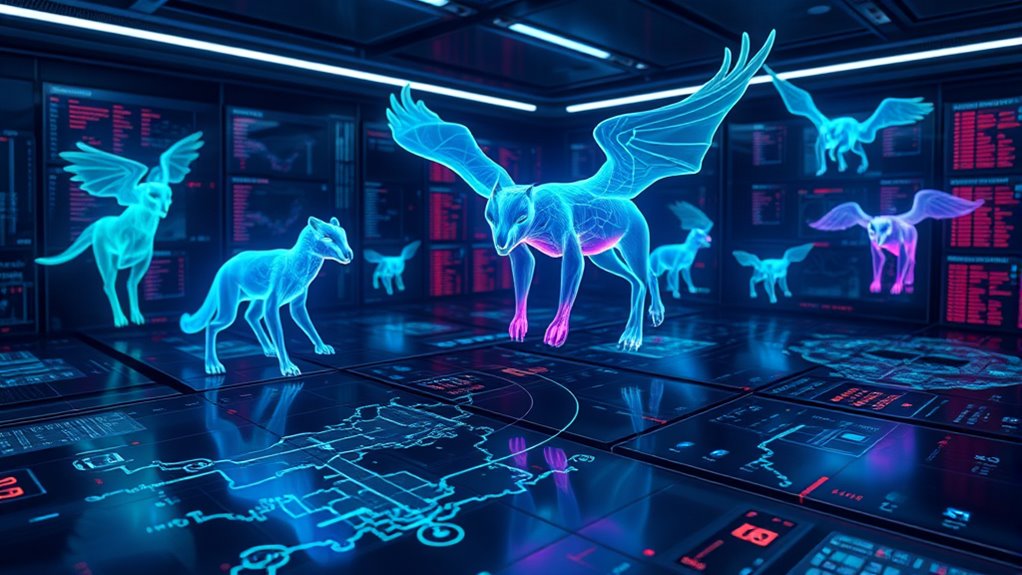
You can create digital witness records to document cryptid sightings accurately and efficiently. Using VR archiving techniques helps preserve these observations in immersive, accessible formats. By implementing these methods, you guarantee cryptid data remains safe, organized, and ready for analysis or public sharing.
Digital Witness Records
Have you ever wondered how digital archives of cryptid sightings are created and maintained? You become a digital witness by submitting your encounters through secure platforms that utilize biometric tracking to verify your identity and authenticity. These records are stored in databases accessible via holographic displays, allowing researchers and enthusiasts to explore sightings in immersive 3D environments. Biometric data helps authenticate reports, reducing false entries and ensuring credibility. When you upload a sighting, your device captures essential signs and location details, which are then integrated into the archive. This combination of biometric tracking and holographic technology creates a vivid, interactive record of cryptid encounters, making it easier to analyze patterns and verify sightings. Your contribution becomes part of a growing digital repository shaping cryptid research.
VR Archiving Techniques
Building on the foundation of digital witness records, VR archiving techniques revolutionize how cryptid sightings are preserved and explored. You can create immersive archives by integrating AR overlays that enhance visual details, providing context and depth to sightings. Biometric feedback captures your physiological responses during reconstructions, offering insights into emotional reactions and engagement levels. These sensors track heart rate, skin conductance, and other metrics, helping archivists refine presentation methods. By combining AR overlays with biometric data, you’re able to develop dynamic, multi-layered archives that feel authentic and interactive. This approach guarantees that future researchers and enthusiasts access rich, detailed, and emotionally resonant records of cryptid encounters, bridging the gap between virtual exploration and genuine experience.
Preserving Cryptid Data
Preserving cryptid data is essential for creating reliable and accessible digital archives that document sightings accurately. You need a systematic approach to cryptid taxonomy, categorizing creatures based on physical features, behaviors, and geographic locations. This helps guarantee consistency across reports and enables effective folklore analysis, revealing patterns and cultural significance behind sightings. Digital archives should incorporate multimedia evidence like photos, videos, and audio recordings, all securely stored with metadata for easy retrieval. You also want to implement version control and data validation to maintain integrity over time. By doing so, you create a thorough resource that supports research, myth analysis, and public engagement, preserving cryptid encounters for future generations while fostering a deeper understanding of folklore and cryptozoology.
Enhancing Public Engagement With Cryptozoology
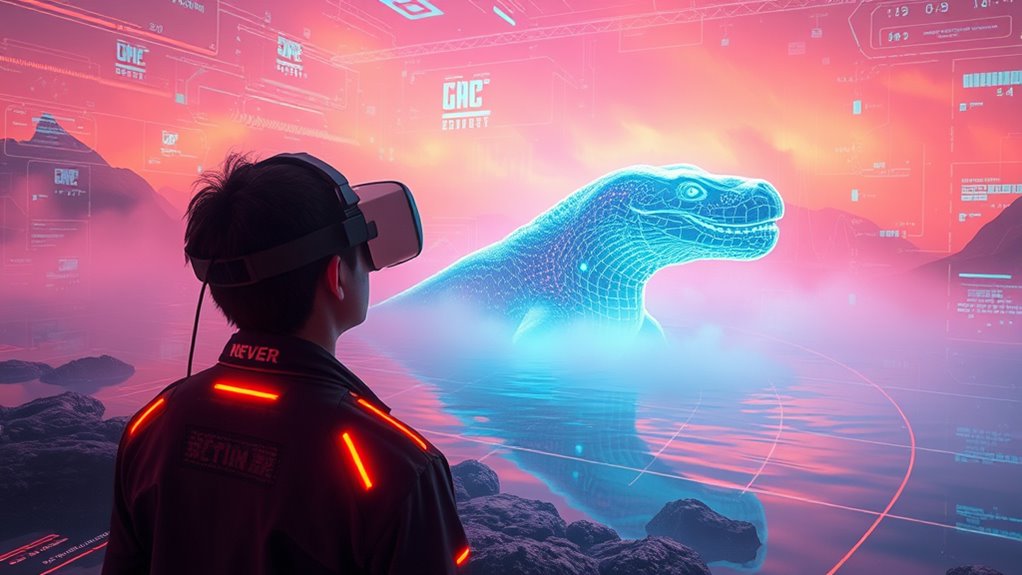
How can the Monster Metaverse make cryptozoology more engaging for the public? By integrating AI companionship and immersive virtual reality gaming, you can explore cryptids firsthand. These tools foster curiosity and interaction, making encounters feel real. Imagine chatting with an AI guide or tracking elusive creatures in a virtual wilderness. To visualize this, consider the table below:
| Feature | Benefit |
|---|---|
| AI Companionship | Personalized cryptid encounters and learning |
| Virtual Reality Gaming | Immersive exploration of cryptid habitats |
| Community Challenges | Collective investigations and shared discoveries |
| Interactive Quizzes | Engaging educational content |
| Live Events | Real-time cryptid sightings and updates |
This approach sparks public interest, encourages participation, and deepens understanding of cryptozoology.
Challenges and Limitations of VR Cryptid Experiences
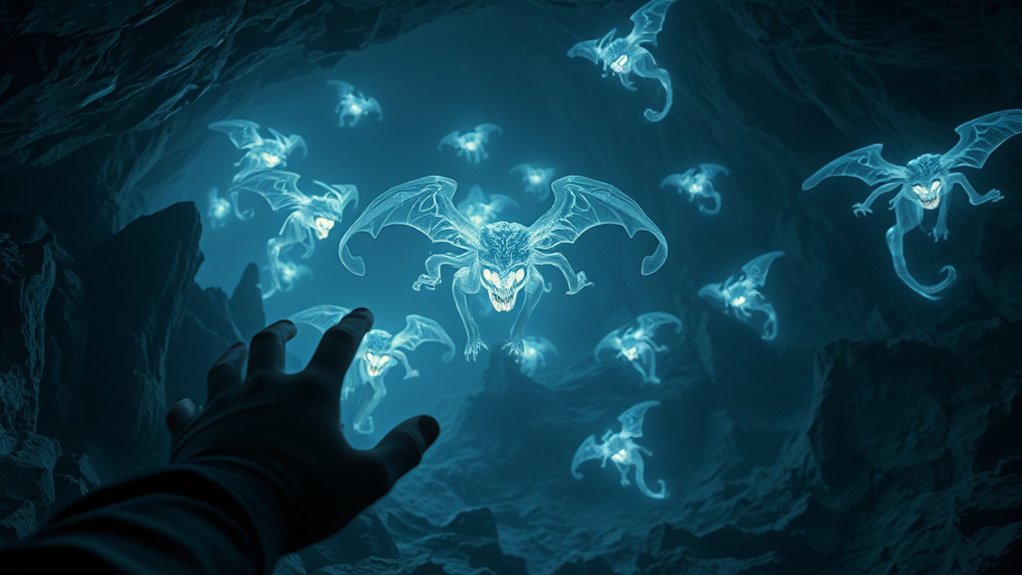
As you explore VR cryptid experiences, you’ll notice technological constraints that can break immersion and make encounters less convincing. Ethical concerns also arise over the authenticity of these virtual sightings, raising questions about their impact on real-world beliefs. Additionally, accessibility and costs can limit who gets to participate, preventing wider engagement.
Technological Constraints Limit Immersion
Despite rapid advances in virtual reality technology, several key limitations still hinder fully immersive cryptid experiences. You might notice that haptic feedback isn’t always convincing, leaving sensations feeling flat or disconnected. Resolution constraints can make visuals appear blurry or pixelated, breaking your sense of presence. Additionally, current VR headsets often struggle with latency, causing delays that disrupt immersion. Finally, the limited field of view restricts peripheral vision, making encounters feel less real. To summarize:
- Haptic feedback often lacks realism, reducing tactile immersion.
- Resolution constraints create pixelation, diminishing visual fidelity.
- Latency issues cause motion sickness or disorientation.
- Narrow fields of view limit peripheral awareness during encounters.
These tech constraints make it challenging to fully believe in cryptid sightings within virtual worlds.
Ethical Concerns Over Authenticity
The rise of VR cryptid experiences raises significant ethical questions about authenticity and deception. You might wonder if these virtual encounters truly represent the creatures or simply fictionalized myths. Authenticity concerns come into play, as users could be misled into believing these experiences are factual or based on real sightings. This raises moral questions about honesty and the responsibility of creators to avoid misleading audiences. Additionally, cultural misrepresentation is a real risk; VR experiences might distort or oversimplify the origins and significance of cryptids rooted in specific cultures. Such misrepresentation can perpetuate stereotypes or erase important cultural contexts. Steering through these ethical issues requires transparency and sensitivity to ensure that virtual cryptid encounters respect authenticity and cultural integrity.
Accessibility and Cost Barriers
While VR cryptid experiences offer exciting new ways to explore mythical creatures, they also face significant accessibility and cost barriers. High-quality VR rigs can be expensive, making it difficult for many to participate. Accessibility challenges include limited hardware compatibility and the need for a powerful computer or console. Additionally, not everyone has a dedicated space for immersive experiences, which can hinder participation. Here are some common obstacles:
- Cost barriers for purchasing VR headsets and equipment
- Limited access for people with disabilities or physical limitations
- Incompatibility with older or less advanced devices
- Lack of affordable options in underserved communities
Overcoming these hurdles is vital to making VR cryptid encounters more inclusive and widely available.
Ethical Considerations in Virtual Cryptid Preservation
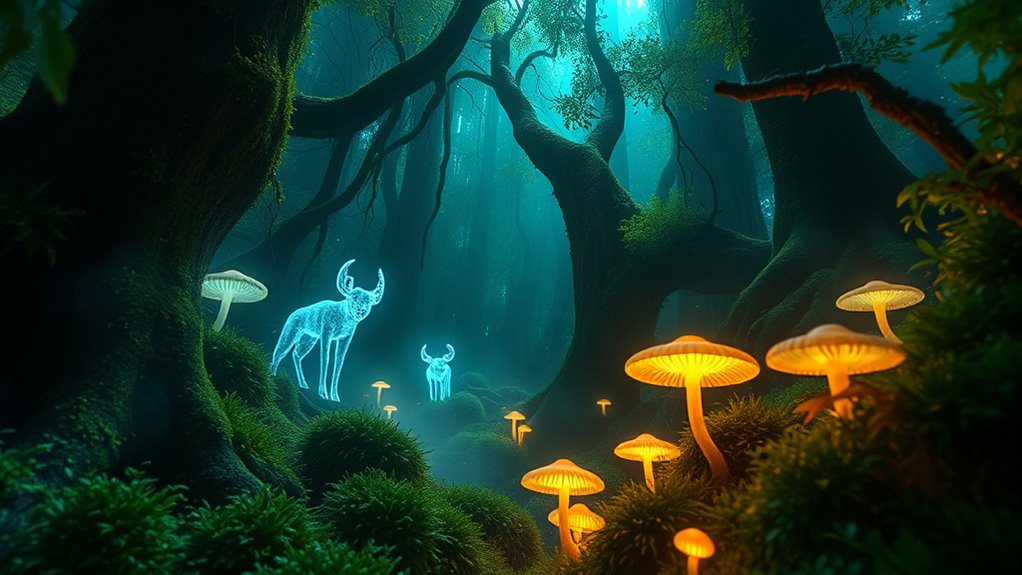
As virtual cryptid preservation gains popularity, it raises important ethical questions about your responsibilities toward these digital entities. Privacy concerns become relevant as these virtual creatures may contain sensitive data or personal stories, risking misuse if not properly protected. You must consider whether these entities have a form of digital autonomy or rights, and if so, how to respect their integrity. Consent issues are equally critical; creators and users should agree on how cryptids are depicted, shared, or altered. Without clear guidelines, you risk exploiting or misrepresenting these entities, undermining ethical standards. You’re responsible for establishing respectful practices that honor the digital consciousness of cryptids, ensuring their preservation aligns with moral principles rather than mere technological capability.
The Role of Community in Shaping the Monster Metaverse
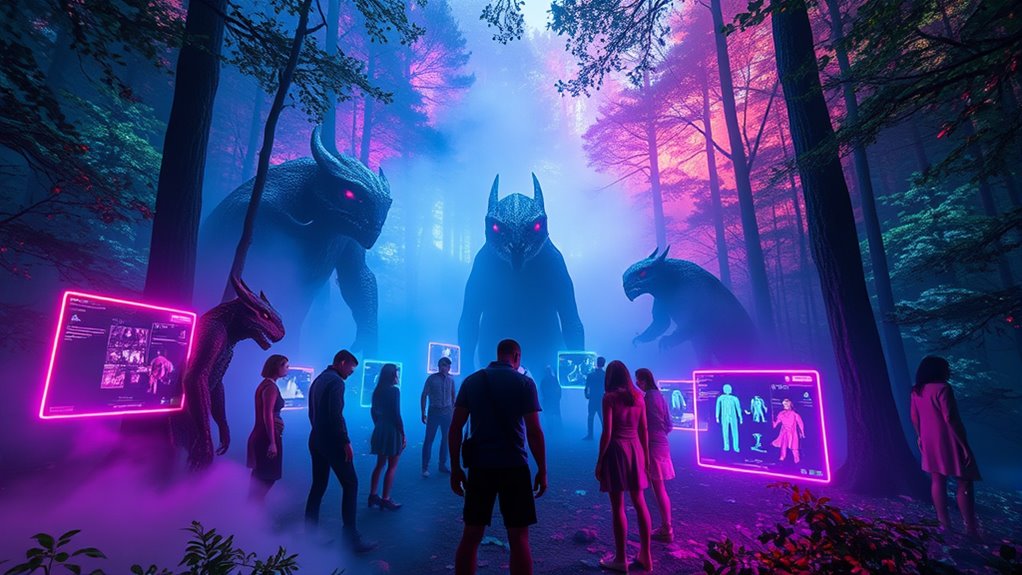
How does community involvement influence the evolution of the Monster Metaverse? Your participation shapes the world through community narratives and collective mythmaking. When you share sightings, stories, or theories, you help build a dynamic, shared mythology that guides the metaverse’s development. Your contributions encourage others to add their perspectives, creating a collaborative environment. Here are four ways your involvement makes an impact:
Community input fuels the Monster Metaverse’s growth through shared stories, habitats, experiences, and collective development.
- Fuels storytelling that forms the backbone of the cryptid lore.
- Shapes virtual habitats based on popular community ideas.
- Creates shared experiences that enhance immersion.
- Influences updates and features through collective input.
Together, your stories and beliefs forge a vibrant, evolving cryptid universe rooted in collective mythmaking.
Future Innovations in VR and Cryptid Exploration
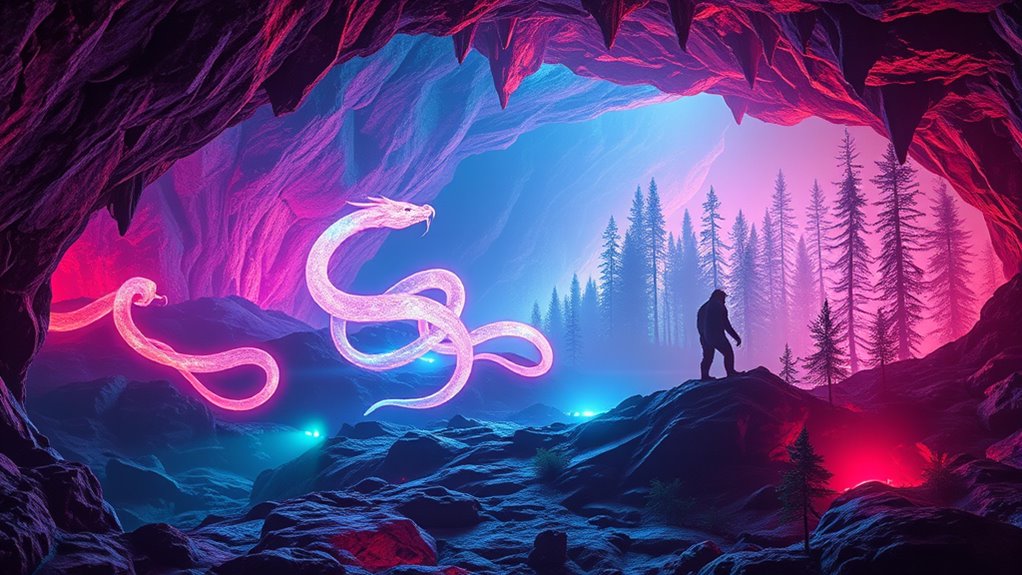
The future of VR and cryptid exploration promises to revolutionize how you experience and interact with these mysterious entities. Advances like quantum entanglement could enable real-time, immersive connections across vast distances, making encounters feel instant and authentic. Neural interfaces will likely become more sophisticated, allowing you to directly link your brain to virtual environments, enhancing sensory perception and emotional responses. These innovations will facilitate deeper exploration, letting you feel as if you’re truly in the presence of cryptids. As technology progresses, you’ll be able to access highly realistic simulations that adapt to your reactions, blurring the lines between reality and virtuality. Ultimately, these breakthroughs will make cryptid encounters more vivid, personal, and scientifically intriguing than ever before.
Potential Impacts on Cultural Heritage and Folklore

Emerging VR and metaverse technologies have the potential to profoundly reshape cultural heritage and folklore by bringing traditional stories and legends into immersive digital spaces. You can experience folklore dissemination firsthand, making myths more accessible worldwide. This technology enables you to:
- Preserve endangered cultural practices through virtual reconstructions.
- Share folklore with global audiences, fostering cross-cultural understanding.
- Engage younger generations with interactive storytelling, ensuring cultural preservation.
- Create collaborative environments where communities can add their own legends and traditions.
Frequently Asked Questions
How Accurate Are Virtual Cryptid Representations Compared to Real Sightings?
You wonder how accurate virtual cryptid representations are compared to real sightings. Digital accuracy depends on the quality of data and technology used, but it can’t fully replicate the nuances of actual encounters. Your perception plays a big role, as immersive VR can enhance realism, yet might also create biases or exaggerations. While virtual depictions aim for authenticity, they often fall short of capturing the true mystery and unpredictability of real cryptid sightings.
Can VR Experiences Influence Public Perceptions of Cryptids?
Your VR experiences can profoundly influence public perceptions of cryptids by shaping digital authenticity and cultural impact. When you engage with realistic, immersive VR encounters, you’re more likely to believe in their existence or share these stories, amplifying their cultural significance. These experiences can blur lines between fact and fiction, making cryptids feel more real and impacting how society perceives folklore, legends, and the mysterious creatures that inspire curiosity and fear.
What Are the Privacy Implications of Sharing Cryptid Sightings Digitally?
Did you know that 80% of users worry about data privacy when sharing sightings online? When you upload cryptid encounters digitally, you risk exposing personal info, potentially compromising your anonymity. Sharing these stories can lead to data privacy concerns, making it harder to protect your identity. Be cautious and consider how your digital footprint might be used or misused, especially if you value personal anonymity in the cryptid community.
How Do VR Cryptid Encounters Affect Traditional Cryptozoology Research Methods?
You might find that VR cryptid encounters influence traditional cryptozoology research by emphasizing digital authenticity, making sightings more convincing. However, it also raises concerns about researcher bias, as virtual experiences could be skewed or manipulated. This shift encourages you to verify evidence carefully and consider how immersive technology impacts credibility. Ultimately, VR offers new tools, but you must remain critical to preserve the integrity of cryptid research.
Will VR Cryptid Archives Become Accessible to the Global Public?
You’ll likely see public access to digital archives of VR cryptid encounters grow, making these immersive experiences widely available. As technology advances, these virtual archives could become part of open resources, allowing enthusiasts and researchers worldwide to explore cryptid encounters firsthand. You might soon access a vast library of VR encounters, bridging the gap between enthusiasts and scientific exploration, and preserving cryptid lore for future generations to study and enjoy.
Conclusion
Imagine stepping into a vast, enchanted forest where every whisper and shadow holds a secret waiting to be uncovered. As you explore the monster metaverse, you become part of a living tapestry, weaving myth and reality together. With each encounter, you help preserve legends that might fade into memory. In this digital wilderness, your curiosity becomes a lantern, guiding future generations through the mysterious, timeless dance of folklore and discovery.

